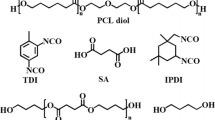Abstract
High-solids polyesters were synthesized with two cycloaliphatic diacids, 1,4- cyclohexanedicarboxylic acid (1,4-CHDA) and 1,3-cyclohexanedicarboxylic acid (1,3-CHDA); and with five diols, 1,4-cyclohexanedimethanol (CHDM), neopentyl glycol (NPG), hydroxypivalyl hydroxypivalate (HPHP), 2-butyl-2-ethyl-1, 3-propanediol (BEPD), and 1,6-hexanediol (HD). The viscosity of the polyesters was dependent on the structures of diols. The viscosity of polyesters is lower with the diol HD, intermediate with BEPD and HPHP, and higher with the diols CHDM and NPG. The polyesters were crosslinked with hexamethylene diisocyanate isocyanurate (HDI isocyanurate) affording polyurethane coatings. The mechanical properties, tensile properties, fracture toughness, and viscoelastic properties were investigated for the polyurethane films with five different diols. The cyclohexyl structure of the CHDM provides the polyurethane with rigidity which is manifested in high tensile modulus, hardness, and fracture toughness. In contrast, the linear diol, 1,6-hexanediol provides polyurethane with very high flexibility, but these coatings suffer with respect to low hardness and tensile modulus.
Similar content being viewed by others
References
Jones, F.N., “Targets for Resin Development in the New Millennium,”Journal of Coatings Technology,72, No. 909, 153 (2000).
Jones, F.N.,Proc. FSCT 78th Annual Meeting Technical Program, Chicago, IL, p. 241, October 2000.
Wicks, Z.W. Jr., Jones, F.N., and Pappas, S.P., “Powder Coatings; IV,”Journal of Coatings Technology,71, No. 895, 67 (1999).
Sherwin, M.A., Koleske, J.V., and Taller, R.A., “Solution Properties of High Solids Intermediates,”Journal of Coatings Technology,53, No. 683, 35 (1981).
Charrière-Perroud, E., inWaterborne & Solvent Based Surface Coating Resins and their Applications, Volume III Polyurethanes, Thomas, P. (Ed.), John Wiley and Sons, New York, Chapt. 5, 1998.
Johnson, L.K. and Sade, W.T., “New Monomers for Polyester Powder Coating Resins,”Journal of Coatings Technology,65, No. 826, 19 (1993).
Heidt, P.C. and Elliott, M.L. “Aliphatic Dibasic Acid-Modified Polyesters Thermoset Industrial Coatings,” Waterborne, High-Solids, and Power Coatings Symposium, New Orleans, LA, February 1995.
Eastman Publication N-341A, “1,4-CHDA Cydoaliphatic Intermediate for High-Performance Polyester Resins,” (October 1994).
Eastman Publication N-327A, “Improved Coil Coating Performance with Eastman 1,4-CHDA,” (February 1995).
Eastman Publication N-342, “Improved Hydrolytic Stability of Waterborne Polyester Resins with 1,4-CHDA and BEPD,” (September 1994).
Eastman Publication N-335A, “Eastman 1,4-CHDA vs. IPA, AD, and HHPA In a High-Solids Resin System Based on TMPD Glycol,” (April 1996).
Ni, H., Skaja, A.D., Thiltgen, P.R., Soucek, M.D., Simonsick, W.J. Jr., and Zhong, W.,Polym. Prepr., Am. Chem. Soc., Div. Polym. Chem., 40(1), 615 (1999).
Heidt, P.C., “Cycloaliphatic-Based Thermoset Industrial Coatings,” Waterborne, High-Solids, and Powder Coatings Symposium, New Orleans, LA, February 1994.
Jones, T.E. and McCarthy, J.M., “A Statistical Study of Hydrolytic Stability in Amine Neutralized Waterborne Polyester Resins as a Function of Monomer Composition,” Waterborne, High-Solids, and Power Coatings Symposium, New Orleans, LA, February 1995.
Ni, H., Daum, J.L., Thiltgen, P.R., Soucek, M.D., Simonsick, W.J. Jr., and Zhong, W., “Cycloaliphatic Polyester-Based High Solids Polyurethane Coatings: II. The Effect of Difunctional Acid,” Submitted toProg. Org. Coat., 2001.
Wicks, Z.W., Jones, F.N., and Pappas, S.P.Organic Coatings Science and Technology, Volume I: Film Formation, Components, and Appearance, John Wiley and Sons, New York, Chapt. 8, 1992.
Jones, F.N., “Toward Solventless Liquid Coatings,”Journal of Coatings Technology, 68, No. 852, 25 (1996).
Huber, H.F. and Stoye, D., inCoatings Technology Handbook, Satas, D. (Ed.), Marcel Dekker, New York, Chapt. 39, 1991.
Turpin, E.T., “Hydrolysis of Water Dispersible Resins,”Journal of Paint Technology,47, No. 602, 40 (1975).
Sullivan, C.J., Dehm, D.C., Reich, E.E., and Dillon, M.E., “Polyester Resins Based Upon 2-Methyl-1,3 Propanediol,”Journal of Coatings Technology,62, No. 791, 37 (1990).
Golob, D.J., Odom, T.A. Jr., and Whitson, R.W.,Polym. Mater. Sci. Eng., 63, 826 (1990).
Jones, T.E., “Statistical Study of Hydrolytic Stability in Amine-Neutralized Waterborne Polyester Resins as a Function of Monomer Composition,”Journal of Coatings Technology,67, No. 844, 57 (1995).
Eastman Publication N-329C, “Triangle Glycol Study,” (June 1998).
Belote, S.N. and Blount, W.W., “Optimizing Resins for Low VOC,”Journal of Coatings Technology,53, No. 681, 33 (1981).
Hill, L.W. and Kozlowski, K., “Crosslink Density of High Solids MF-Cured Coatings,”Journal of Coatings Technology,59, No. 751, 63 (1987).
Hill, L.W., Kozlowski, K., and Sholes, R.L., “Theory and Practice of Viscosity Reduction in High Solids Systems,”Journal of Coatings Technology,54, No. 692, 67 (1982).
Ballard, R.L., Sailer, R.A., Larson, B., and Soucek, M.D., “Fracture Toughness of Inorganic-Organic Hybrid Coatings,”Journal of Coatings Technology,73, No. 913, 107 (2001).
Nichols, M.E., Gerlock, J.L., Smith, C.A., and Darr, C.A.,Prog. Org. Coat., 35, 153 (1999).
Author information
Authors and Affiliations
Additional information
Polymers and Coatings Department, Fargo, ND 58105.
3401 Grays Ferry Avenue, Philadelphia, PA 19146.
Rights and permissions
About this article
Cite this article
Ni, H., Daum, J.L., Soucek, M.D. et al. Cycloaliphatic polyester based high solids polyurethane coatings: I. The effect of difunctional alcohols. Journal of Coatings Technology 74, 49–56 (2002). https://doi.org/10.1007/BF02697983
Issue Date:
DOI: https://doi.org/10.1007/BF02697983




